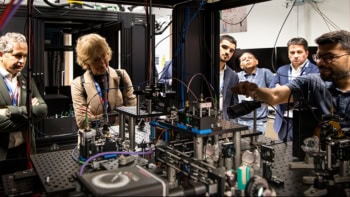James McKenzie is excited about the prospects of firms that are developing technology based on seemingly esoteric fundamental quantum phenomena

Physicists have long boasted of their success in what’s known as “quantum 1.0” technology – semiconductor junctions, transistors, lasers and so on. Thanks to their efforts over the last 75 years, we have smart phones, computers, laptops and other quantum-enabled devices that have transformed our lives. But the future will increasingly depend on “quantum 2.0” technology, which taps into phenomena like superposition and entanglement to permit everything from quantum computing and cryptography to quantum sensing, timing and imaging.
The incredible possibilities of quantum 2.0 were brought home to me when I attended the UK’s National Quantum Technologies Showcase in central London last month. The event featured more than 60 exhibitors and I was amazed how far things have progressed. In fact, it coincided with two positive developments. One was an announcement by UK Research and Innovation (UKRI) of a further £50m to support quantum industrial projects. The other was the UK and US signing a joint “statement of intent” to boost collaboration on quantum science and technologies.
The future will increasingly depend on “quantum 2.0” technology, which taps into phenomena like superposition and entanglement
The £50m from the UKRI is part of its £170m Commercialising Quantum Technologies challenge, which has already awarded £103m in grants over the last three years. The challenge forms part of the UK’s National Quantum Technologies Programme (NQTP), which was set up in 2014 to fund and spur on the rapidly growing UK quantum industry. As challenge director Roger McKinlay told delegates: “Quantum is no longer a technology of the future but a technology of today.”
Like many other nations, the UK is keen to turn its scientific prowess in to industrial success, creating jobs, exports and economic benefits. It’s been a rosy picture to date, with management consultants Anchored-In reporting that 41 quantum-tech companies have been created in the UK since 2013, together raising over £245m in investment and employing 590 people. This year has also seen one of the first acquisitions in the sector, with Honeywell buying Cambridge Quantum Computing to form a new joint entity. London-based quantum-encryption start-up Arqit, meanwhile, went public to provide $400m for satellite-based quantum key distribution (QKD) secure communications.
Award winners
The London event showcased some fantastic technology ideas and prototypes from the UK’s four quantum-technology hubs, which the NQTP set up in 2014 to accelerate the commercialization of quantum 2.0 products. I was particularly pleased to see companies that have won business awards from the Institute of Physics (IOP) this year. They included Toshiba, which won an IOP business innovation award for its technology that can protect telecoms infrastructure from cyber-security threats.
The firm used the London event to showcase its QKD system, which is already being used on fibre networks across Europe, the US and Japan. It has the highest key transmission rate on the market and operates along distances of more than 100 km. Toshiba hopes to extend this figure to 600 km by cancelling out temperature fluctuations in the fibre, which otherwise scramble the bits of the key, using a technique called “dual-band stabilization”.
Another firm showcasing its wares in London was Aegiq, which won an IOP business start-up award this year. Spun out of quantum-photonics research at the University of Sheffield in 2019, it has received more than £3.5m of funding to develop its “iSPS” technology, which produces indistinguishable single photons. The first application is expected to be in satellite QKD, with iSPS offering speeds 10 times higher than the best currently available. As satellites have only perhaps a 100 s contact time with base stations, the firm’s technology will allow data to be sent in more secure bursts. Its first product could be out next year.
I was also intrigued by Quantum Dice, which won an IOP business start-up award this year for developing a “true” random-number generator. Emerging from research at the University of Oxford, the firm’s technology, which is device-independent, can securely generate keys for quantum encryption. Its big innovation is its “self-certification” routine, which guarantees that the output numbers have the maximum amount of randomness that can be extracted. Quantum Dice has already raised £2m in investment.
It was great to see past IOP award winners making great progress too. One was Orca Computing, which bagged an award in 2020 and now employs 20 people, has raised more than £3m in funding and recently received coverage from the BBC for its claims to have made the world’s smallest quantum computer. Operating at room temperature – how cool is that! – the four-qubit device fits into a standard-size server rack and was launched at the London event.
Quantum 2.0 is not just a buzzword: it’s reality
Another 2020 IOP business start-up award winner in London was Photon Force, which makes single-photon avalanche detectors for sensor arrays and cameras. Its staff and revenues have doubled over the last year, with the company funded from sales, R&D contracts and grant revenues. Its technology is being used in the £2.6m BP-led HYDRI project, which can spot potentially dangerous hydrogen leaks. The firm is even working with Facebook Reality Labs to use its array in a brain-computer interface project.

What can the quantum world do for business?
Then there was QLM Technology, which won an IOP business start-up award in 2020. It makes low-cost, low-power, tunable-diode LIDAR gas-imaging systems based on infrared single-photon detection. They can monitor leaks of methane – a potent greenhouse gas – from gas and oil wells. QLM’s prototypes can reveal parts-per-million levels of methane at distances of up to 200 m. Having raised £3.1m earlier this year, its first full product is out now.
Despite the great progress on show in London, “deep-tech” firms like these take time to develop and mature. But if we can sustain support for such pioneering firms, they should continue to grow, secure further investment and release products. Quantum 2.0 is not just a buzzword: it’s reality.



